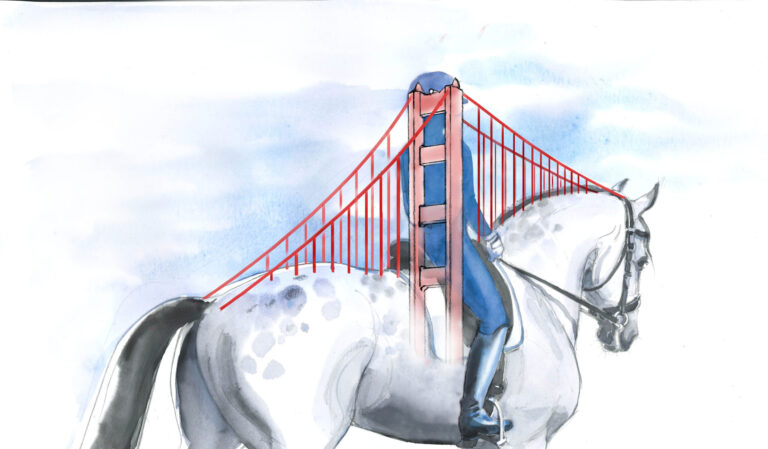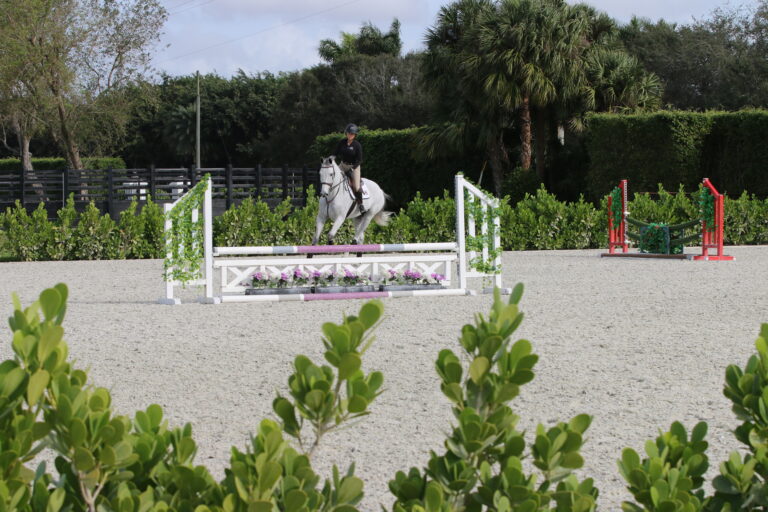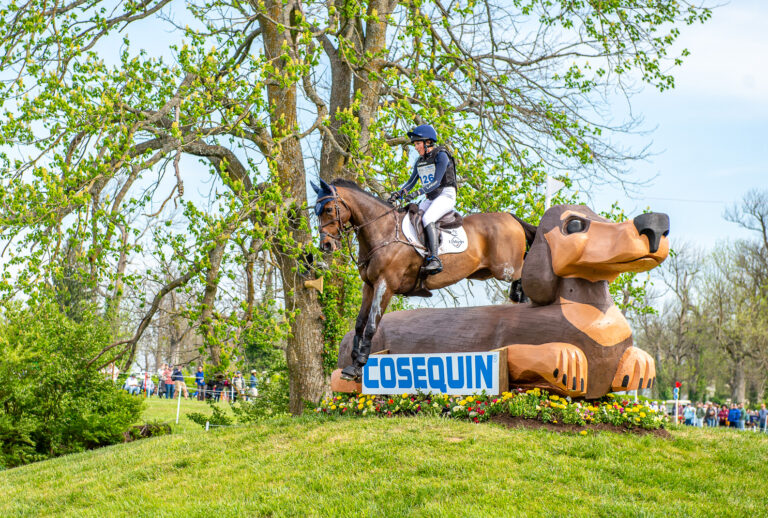Have you ever ridden a perfect line in the hunter ring, only to miss a lead change afterward, diminishing, and often eliminating, your chances of placing in the class? If so, you’re not alone. While lead changes come easily and naturally to some horses, they can be challenging for others, and as a rider, you must learn how to correctly ask your horse to change leads.
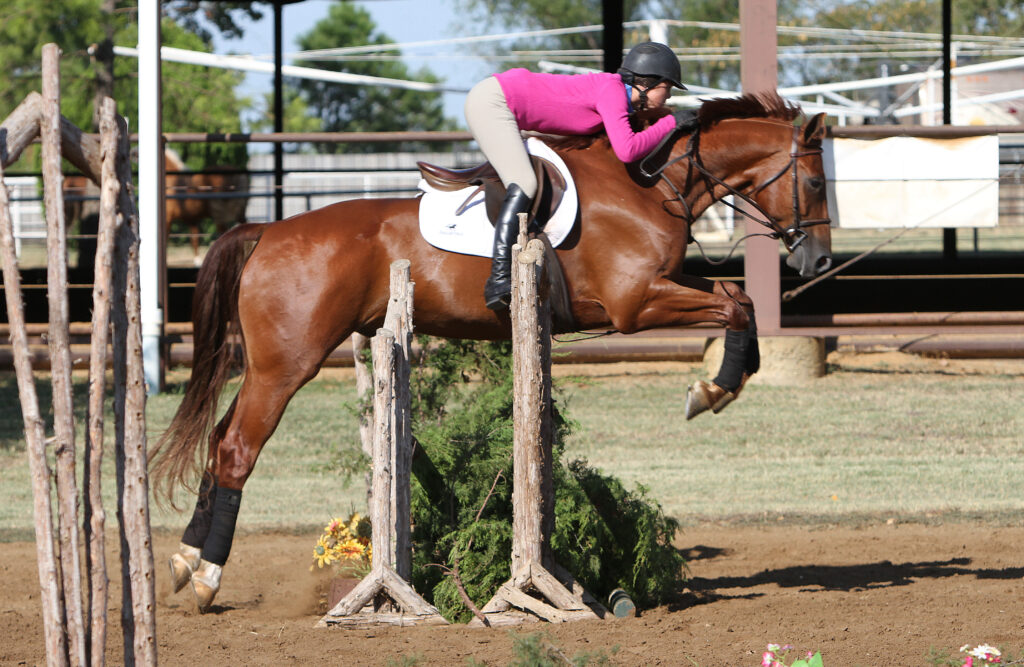
During a flying lead change, the horse first is on one lead where both of his inside legs literally lead the canter stride, pushing from behind to drive the forward motion. He then balances himself and swaps the order of his leading legs, so the opposite legs lead, all while maintaining forward motion.
Keep in mind that flying lead changes after jumps—where your horse lands on the left lead, for example, and must change to the right lead so he can navigate a smooth right turn—are about more than getting a check mark from the judge. Being on the correct lead helps your horse balance because horses generally are more comfortable and confident on the lead that corresponds to the direction they’re traveling. Being on the correct lead can also affect the quality of your next jump. To execute a lead change, you must ask your horse to slow down and collect himself so he’s calm and smooth through the change. After the change, that working canter will allow you to ride a smooth turn to find the best distance to your next jump. Thus, being on the correct lead will ultimately improve your entire course.
Some trainers try to fix lead issues by using larger spurs or stronger bits, but getting a successful change is more about desensitizing your horse to anxiety. When a horse is anxious about changing leads, he won’t be able to listen for information from his rider about what he’s to do next. To desensitize him, you need to slow down the entire process. This allows you to access his brain through your hand and leg aids to relay the information he needs to execute a flying change.
In this article, I’ll teach you my system to correctly ask for and get a flying change after a jump. You can use my method whether you’re teaching a young horse or are refreshing a more seasoned partner. My system includes a progression of the following exercises:
- Prepare your horse with proper flatwork.
- Practice simple and flying changes on the flat.
- Trot jumps and halt in a straight line.
- Ride simple changes after a fence.
All of this work will greatly improve your chances of getting the flying change after a fence, which is the final step.
Before beginning, I have a few tips for success:
- Use a basic snaffle bit because it’s likely the bit your horse is most comfortable and responsive in, especially if he is ready to begin lead-change work. I don’t like using a bit that’s too strong or complicated. If, however, you’re unsure about the type of bit to use, consult your trainer. I occasionally recommend using a pelham if, for example, I have an older, stronger horse. A pelham can help you rate your horse’s pace a bit better because of the smaller shank; plus, the curb strap adds slight pressure under the horse’s chin.
- It’s important to treat horses as individuals, so use additional equipment based on your horse’s specific needs. For example, if your horse needs a smaller or longer spur because he’s responding quickly or sluggishly, then make a change to best manage the schooling situation.
Fundamental Flatwork
A well-trained horse on the flat will often quickly excel over fences. If, for example, your horse responds to your slow-down cues during flatwork, he’ll more likely collect when you ask him to do so in a quiet line between fences. The same principle applies when asking for lead changes after a fence. If your horse responds to your aids on the flat, he’ll more readily respond to your cues to rebalance after a fence and execute a flying change.
So spend time, especially with young horses, revisiting his ABCs at the walk, trot and canter. These include promptly responding to all of your aids to move forward and come back and turn left and right. Increase the technical level slightly by asking your horse to bend and straighten, and work on lengthening and shortening his stride, always asking him to move forward from your leg into a definite, yet elastic, contact.
The horse in the photos for this article, Brent, is learning how to get his lead changes after fences. He’s naturally well-balanced and has good cadence, and he’s also very scopey—there’s a lot of length and thrust in his stride and jump. Our challenge is to get him to slow down, wait, respond to the bit and collect his enormous stride, or he’ll miss his changes. In Photo 1, his balance and cadence are OK, but the rider, my assistant, Alexandra Ansteth, doesn’t have control of his scope yet. Because he’s not moving forward from her leg into a definite contact, she’s not able to rate his speed and position him well. This would make it difficult for her to ask for a flying change.

In Photo 2, the thrust of Brent’s stride is greatly improved. He’s responding to Alexandra’s leg to move forward into a definite contact, which will help him understand and respond to her aids to get a flying change. As you look at the photos, though, keep in mind that Brent is learning how to connect his hind end to his front end, give to the bit and collect his stride. I don’t want to see him behind the vertical and I don’t want to see him drop his head and neck too low. But often horses will go through this stage until they become more comfortable giving to the bit and learning that collection doesn’t mean only to give his head but to connect his hips to his shoulders and to lift his shoulders.
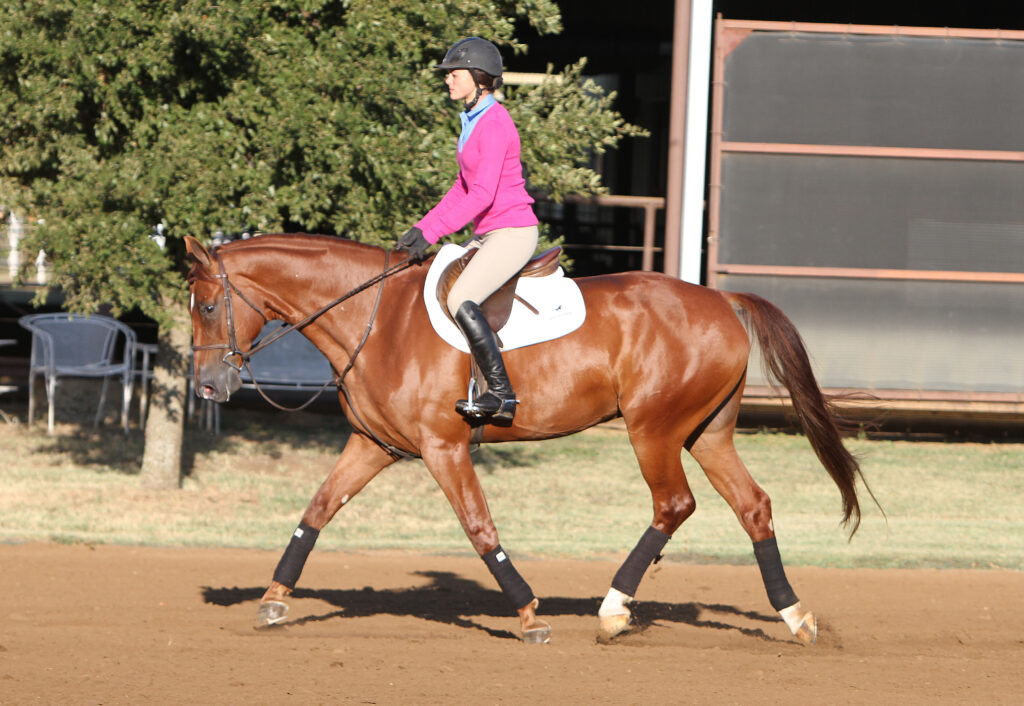
You’ll notice these same position details in the photos of the uncollected and collected canters (below). But Brent is quickly learning to connect his haunches to his front end, and he’s allowing Alexandra to move his haunches in, which will ultimately relate this flatwork to lead changes after jumps.
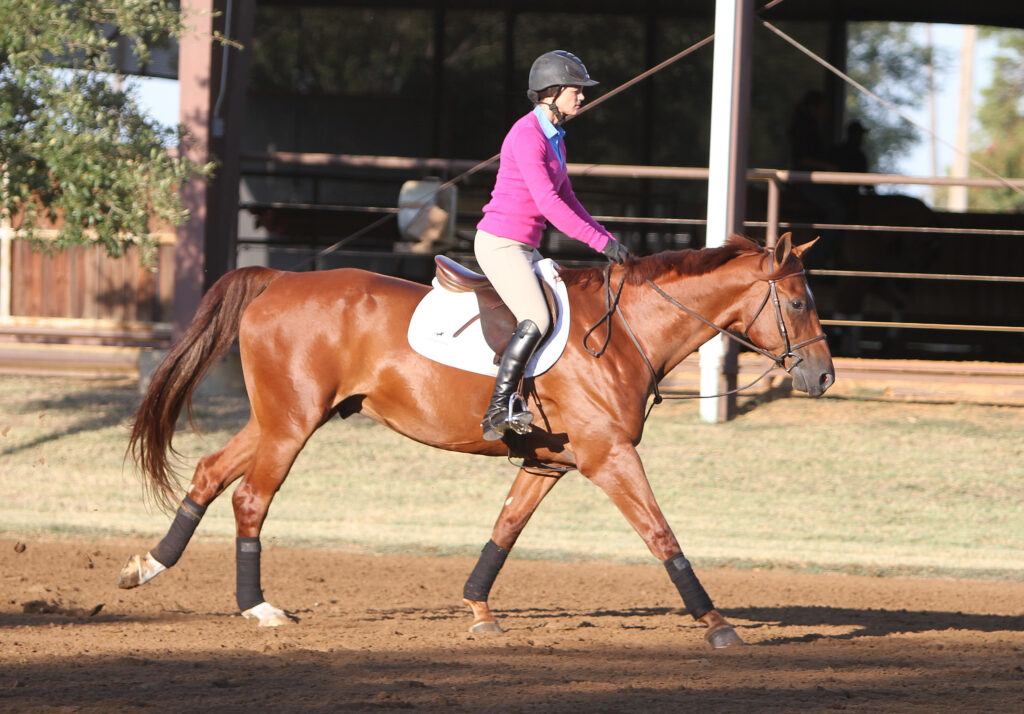
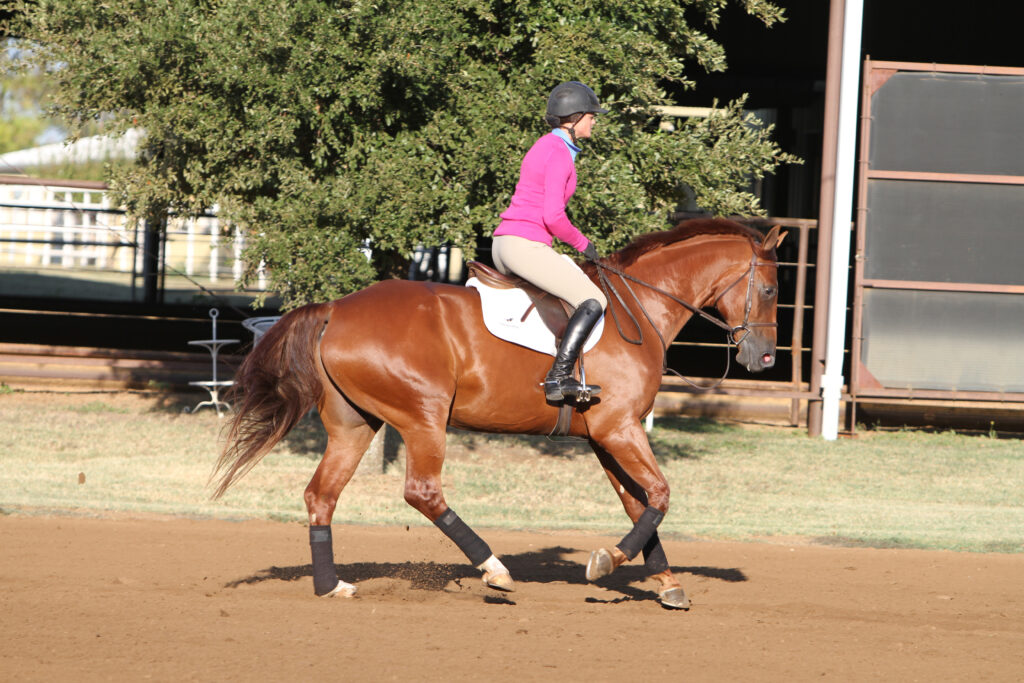
Lead Changes During Flatwork
A Simple Change
You’ll begin to teach your horse the aids for a flying change by executing simple lead changes on a straight line. In a simple change, a horse is cantering on one lead, the rider then brings him back to trot for a few steps and next asks him to pick up the opposite lead. Riding a simple change will help you and your horse understand the leg aids you need to use to shift his haunches in the direction of the new lead. This will also prevent him from leaning and dropping his shoulder (in the direction of the new lead) in anticipation of a direction change.
I’ll start by describing a simple change from the left lead to the right lead. If your horse is anxious or has preconceived worries about one particular lead, I recommend you begin this exercise by starting on the lead that’s more difficult for him.
1. Ask your horse for a forward, connected walk to the left. Make sure you are sitting directly in the middle of your saddle.
2. Ask him to pick up a left-lead canter. Once he is cantering comfortably and smoothly, turn onto a straight line across the diagonal and canter for a few strides.
3. Return to the trot and collect for a few steps, making sure to keep your horse straight, which will keep him balanced. Remember to sit tall and centered in your saddle, which also will help his balance.
4. Pick up the right lead: Move your left leg back slightly behind the girth to push your horse’s haunches in slightly to the right, toward the direction of the new lead. Using your left rein to hold your horse straight, apply a little pressure with your right rein and squeeze with your left leg to encourage your horse to pick up his right lead.
5. Canter to the end of the arena and then return to the walk. Repeat the same exercise across the arena, beginning with your right lead and reversing the cues I gave you.
After you’ve practiced doing one simple change on a straight line and your horse remains relaxed, incorporate two simple changes and eventually three changes. You can repeat this exercise a number of times. I also recommend you work the exercise on a straight line up and down the center of your arena. This will especially help a horse who anticipates or worries about a lead change on a diagonal line.
Keep in mind that simple lead changes can initially be somewhat sloppy—this is how your horse starts to think about the change: “I gotta get my legs ready to get going in the new direction.” With practice, your horse will become more technical and prompt.
A Flying Change
Once your horse is doing simple changes comfortably and smoothly, ask for a flying change across the diagonal, described here as a left-to-right change.
1. Pick up and establish a smooth, collected left-lead canter.
2. Ride across the diagonal for a few strides, keeping his head and neck flexed slightly to the left (being sure his body
is straight).
3. Collect his stride a little by opening your right shoulder away from his right shoulder.
4. Remaining centered in the saddle to help him maintain his balance, ask for the change: Ask for a slight right bend and use a strong left leg. This will give him the information he needs to change to the right lead.
5. Continue cantering to the end of the ring, then ride a nice transition to the walk.
Be sure to give your horse a break at the walk after he successfully completes a change, or even if he misses it, because it’s important that he stay relaxed. Plus, it gives him a moment to contemplate what you are asking of him.
‘You can repeat this flying-change exercise several times a day in both directions, but don’t expect perfection and don’t tire your horse to the point he becomes anxious about the change. If you simply cannot get the flying change, revert to the simple-change exercise, this time asking him to move his haunches in a bit more when you’re trotting between leads. On the other hand, once your horse masters the flying change, don’t overdo them, especially in areas of the arena where he’ll anticipate them.
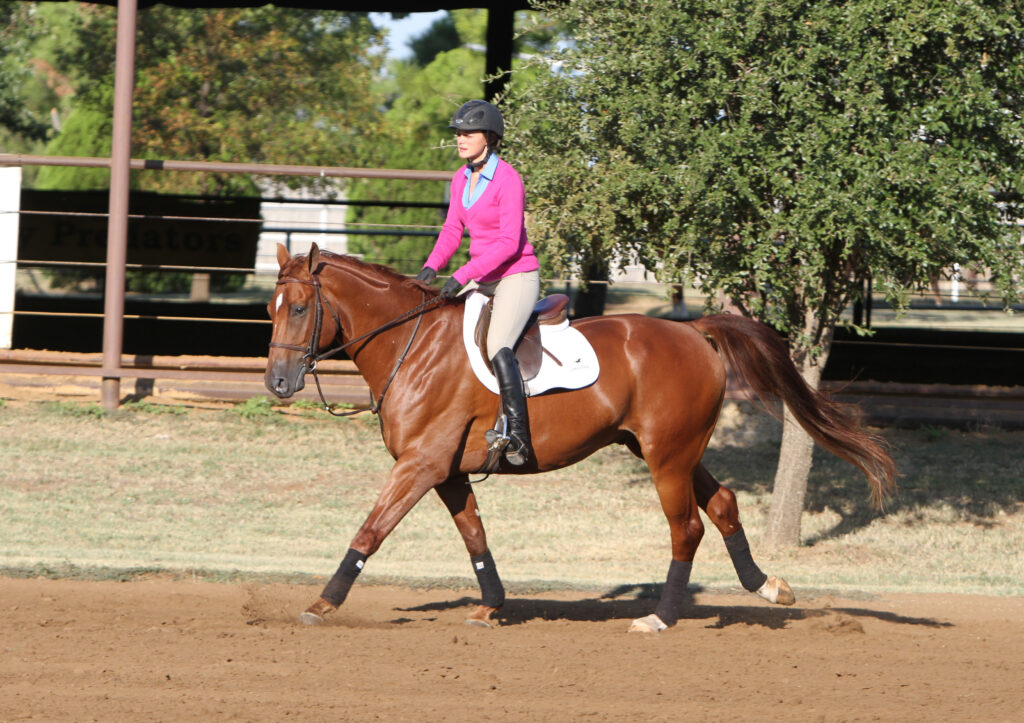
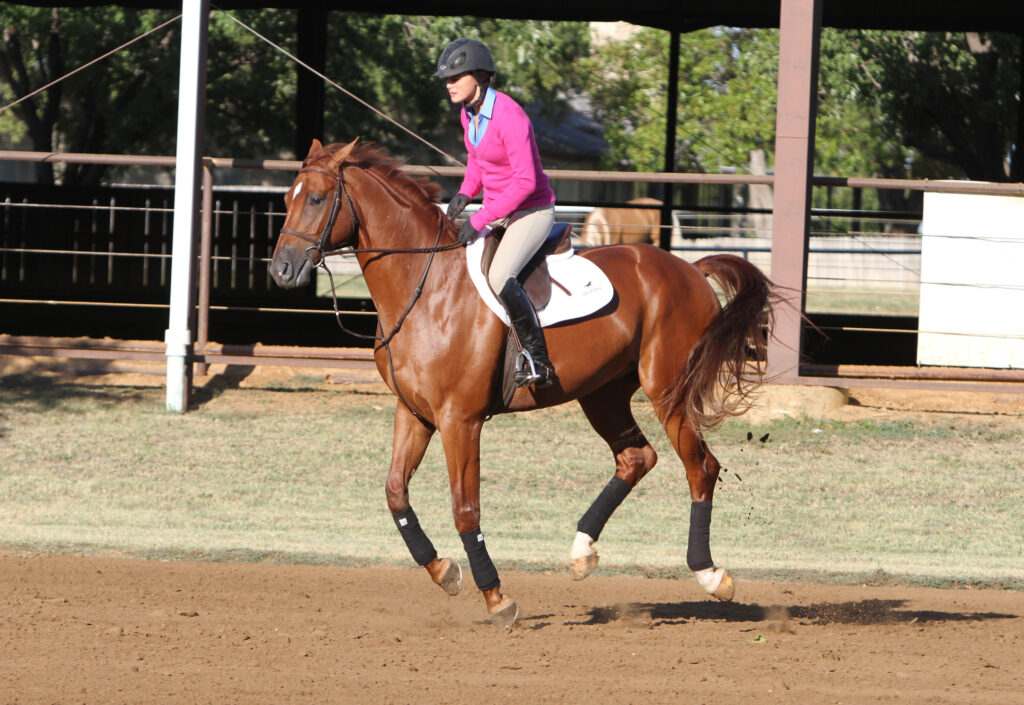
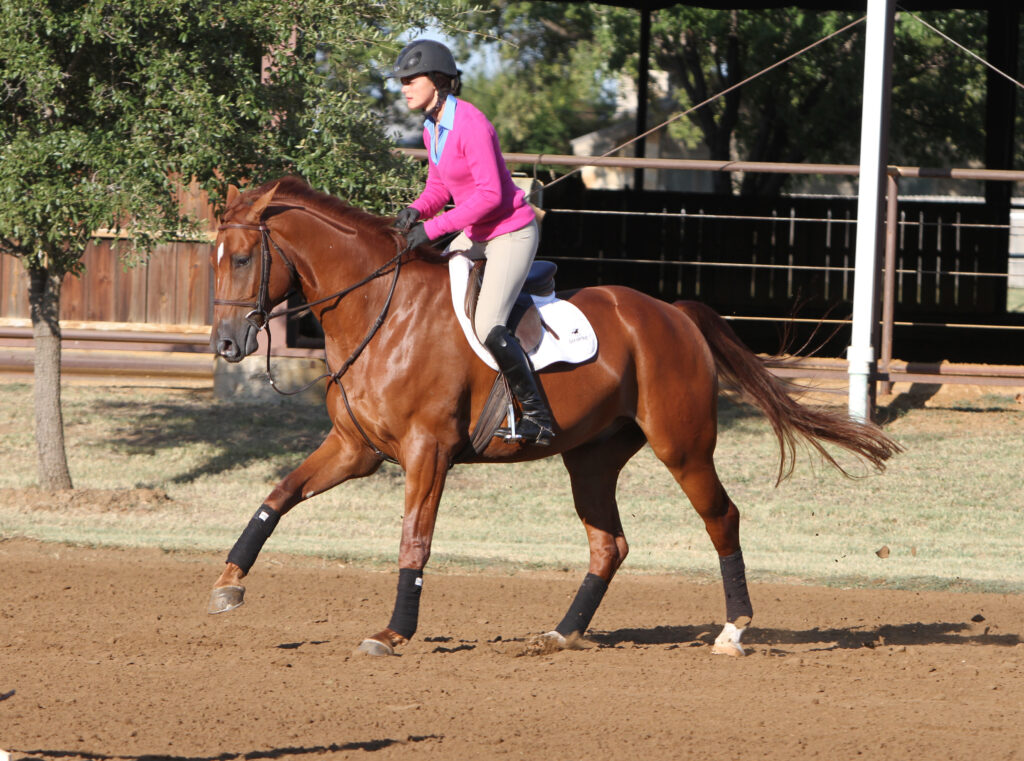
Once your horse is riding simple and flying changes on the flat smoothly and calmly, you can …
… Ride a Trot Jump and Halt
Before you begin incorporating lead changes after your jumps, always do several trotting jumps and then halt. Focus on cantering away from the fence, keeping your horse straight and calm between your legs and hands?no matter what lead you land on?then stop straight.
This will help prepare your horse for a flying change after a fence because when trotting smaller jumps, he doesn’t have to use a great deal of scope and will usually land quietly and regain his balance more easily. Furthermore, stopping on a straight line is crucial in preparation for flying changes because your horse must think about responding to your request to balance himself while ?elevating his front end and stopping on his hindquarters. Eventually, a canter jump will serve the same purpose. Start low and keep the exercise simple for your horse to help him succeed in flying changes.
When trotting jumps to set up for a lead change after a fence, I like to set a guide rail approximately 7 feet in front of and parallel to the trot fence. Trot your horse up to and over the guide rail, then continue trotting to the fence. Not only will this help you study the feel, cadence and power of your horse, it will give you insight into his energy level?whether he’s spooky, calm or fresh. These indicators will tell you what measures you need to take to get your horse listening to your aids for the flying change.
Simple Change After a Fence
I like to allow a lot of space to get a horse set up and positioned for the change so he’s not anxious, which will likely result in a poor jump. To do this, I set up a single fence on the long side of the arena, a little closer to the approach side, so there’s more room on the landing side.
To ride the fence and do a simple change from the left to the right lead:
1. Pick up a canter and canter to the single fence. At this stage, simply focus on the fence and not on the lead change. I never want a horse to worry about the lead change so that it negatively affects his jump.
2. After the jump, check the lead you landed on by feel or quickly glance down at your horse’s shoulder. If he landed on the left lead, you’ll need to ask him to change to the right lead for a smooth, balanced right turn.
3. Canter four or five strides, asking him to collect a little more each stride.
4. Ask your horse to return to a collected sitting trot, making sure you stay centered in your saddle while keeping him straight.
5. At the trot, open your shoulders to help your horse draw his shoulders up a bit. This will help you feel where his hips are so you can use your left leg to push his hips to the right and encourage him to step off on a very technical and proper right-lead departure.
Practice the simple changes in both directions until your horse reliably rides them smoothly and calmly. Remember, though, if you don’t get an accurate simple change, you’re not likely to get a flying change.
Flying Change After a Fence
To ride a flying change after a fence:
1. Approach the single fence the same way you did when practicing simple changes.
2. If your horse lands on the left lead after the jump and you need to change to the right, as in the photos above, first collect his canter four or five strides as you did when you were riding the simple change.
3. Open your shoulders away from your horse’s front end a bit to collect your canter. Be careful not to pull on your right rein, as this will encourage your horse to lean on his right shoulder and prevent you from getting a clean change.
4. At the same time, get your horse straight and underneath you by using a little right calf against his side. Pressure from your right calf will support his right side and discourage him from dropping his right shoulder.
5. If your horse is a bit strong or has a big stride, try pushing him from your right calf into your left rein to collect him. But don’t pull his head to the left?a mistake I see many riders make. Doing this pushes his right shoulder in and puts more weight on his right hind leg, which makes it more difficult for him to change leads from behind. Your aim is to hold him straight, not bend or lean to the right or left.
6. Check that you’re sitting tall and straight in the saddle.
7. When you feel you’ve properly collected your horse’s canter and he’s straight, decrease your right-leg pressure, ask for a slight right bend and use a strong left leg. Your horse now has the information to change from the left to right lead.
If your horse doesn’t readily change, use a little more left leg and, if need be, the aid of a small spur. Also, check that you aren’t leaning or twisting your upper body.

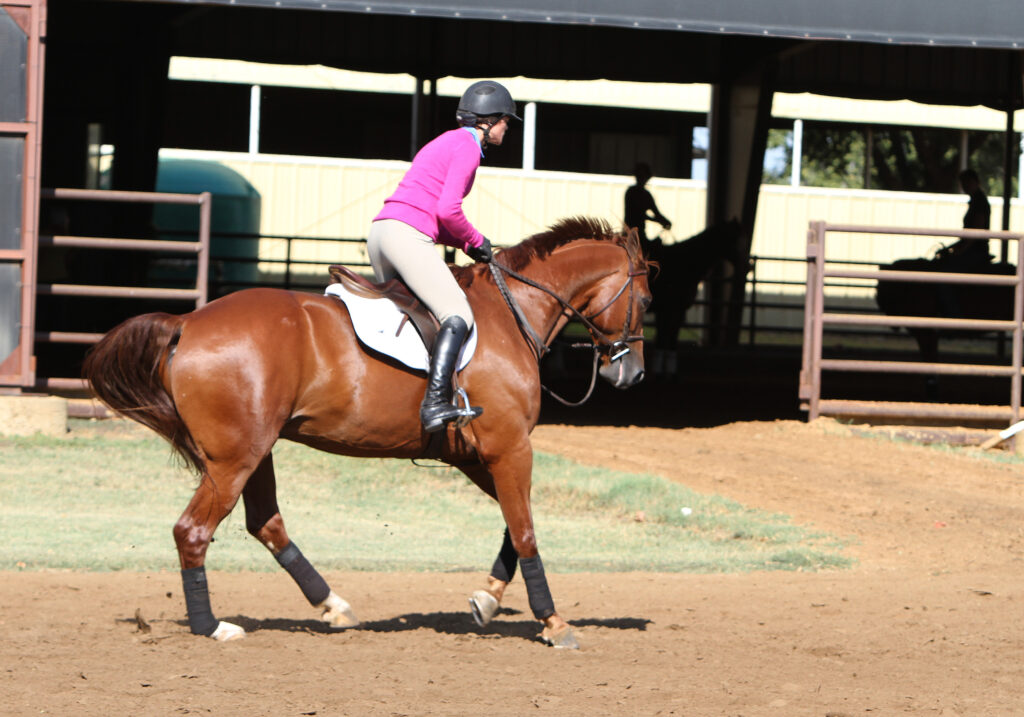
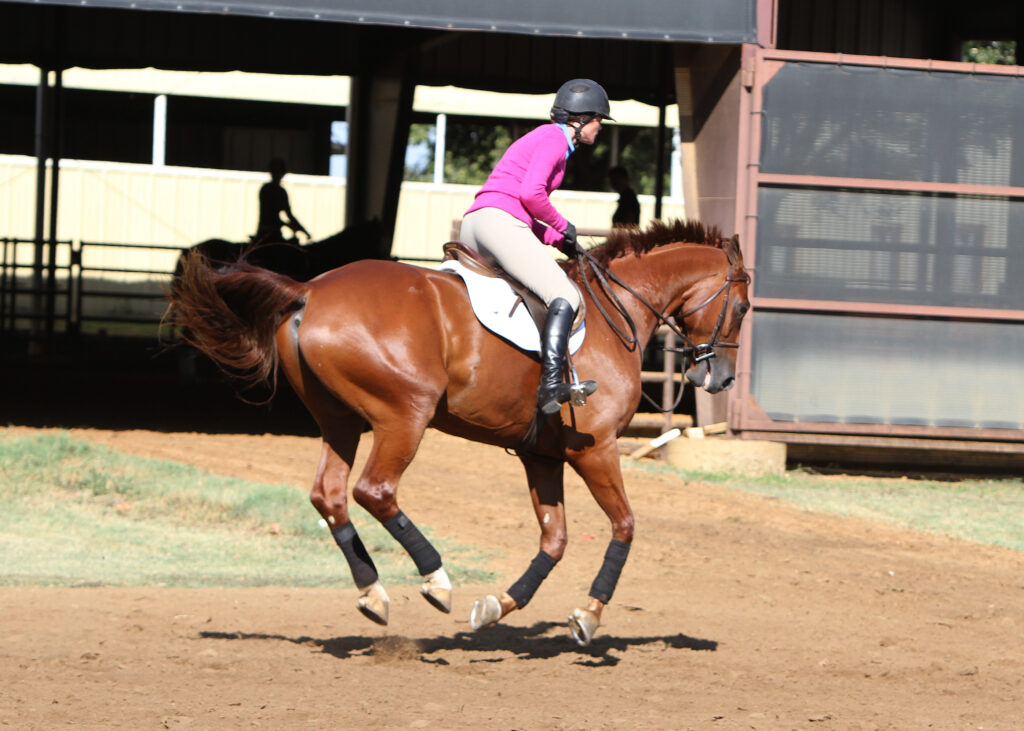
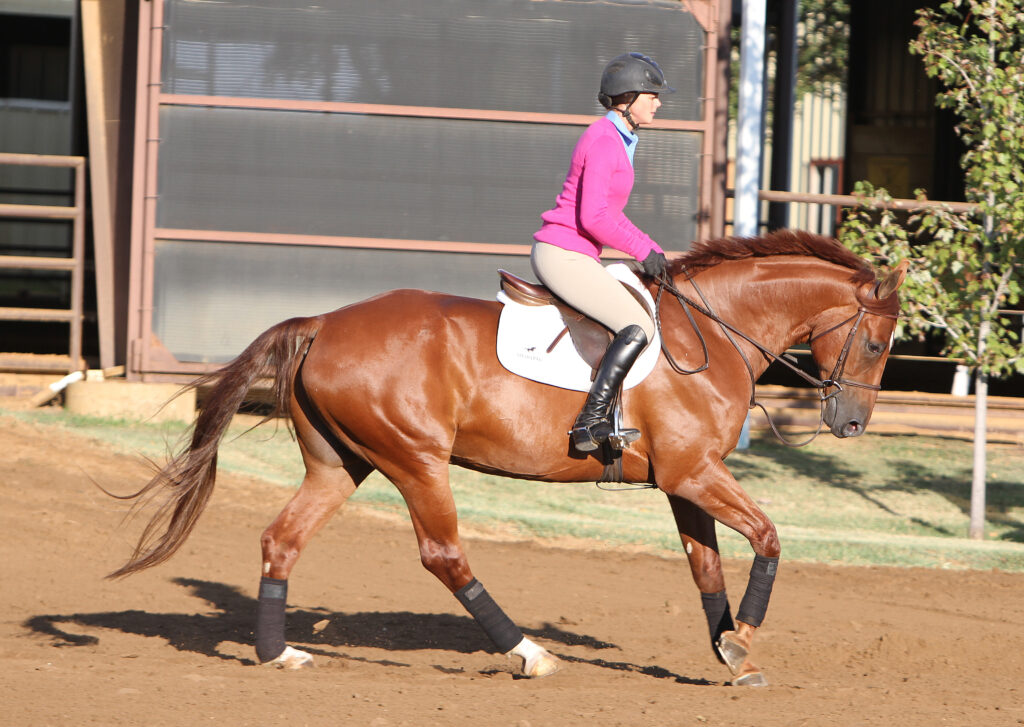
Once your horse understands that he’s going to rebalance after every fence, he’ll start to relax. This will enable him to listen to your aids for a flying change. Then they’ll become stress-free and just part of a beautiful course.
About Colleen McQuay

Colleen McQuay owns and operates McQuay Stables Inc., with her renowned reining husband, Tim, in Pilot Point, Texas. Over the past 35 years, Colleen has trained both horses and riders to numerous wins and championships. Her students have earned youth, amateur and open American Quarter Horse Association World Championships and numerous All American Quarter Horse Congress titles. Her students have also earned U.S. Equestrian Federation hunter championships and repeatedly placed near the top.
As a rider, Colleen earned numerous USEF championships in the hunter divisions while also competing in AQHA shows. She’s a six-time Congress Champion and has won numerous AQHA World Championships.
She has trained and developed horses, such as Stallone, who placed in the top 10 in the USEF Large Junior Hunter division; River Rodes, who placed in the top 10 in the USEF Amateur-Owner Hunter division; Brother Streakin, a two-time AQHA Open Jumper World Champion; Lonsum Zippos, an AJQHA and AQHA Senior Working Hunter World Champion as well as AQHA/AHSA Best of America’s Horse Small Junior Hunter Champion; and Silver Spirit, a USEF Show Jumping Talent Search Finals winner. With assistant Alexandra Ansteth (who demonstrates the exercises in this article) in the irons, Colleen currently divides her time training hunters and jumpers and assisting with her husband’s reining training. She also conducts clinics and assists other trainers in developing their training programs.
Colleen served on the U.S. Hunter Jumper Association Open Hunter Task Force, and is a founding member of the USHJA International Hunter Derby. After decades in the industry, her sincere love of horses permeates and guides her work–from administrative direction to hands-on horsemanship.
This article originally appeared in the June 2013 issue of Practical Horseman.





